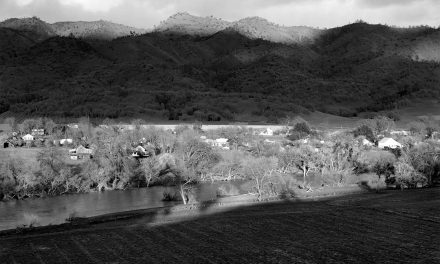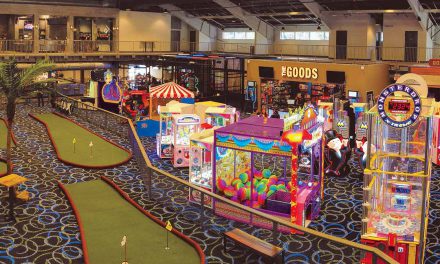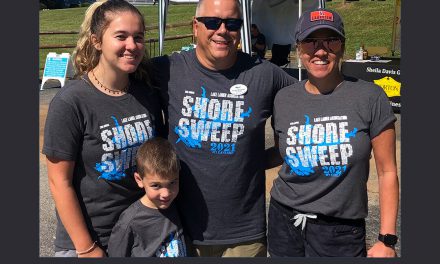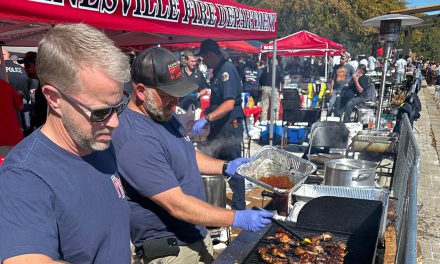Although I first visited Thailand seven years ago as part of a 3-week Southeast Asia trip through Overseas Adventure Travel, the images I captured – and the friendships I made – stuck with me. I had stayed in touch with my trip leader on that original journey, Leky Ondej, a bit sporadically over those years, but I always remembered her kindness, knowledge and friendship.
When the chance to travel to the other side of the world in early October came up, it was a no-brainer to include a week in Bangkok to see my friend again. When we connected through a Facebook call last spring, it was like we’d seen each other only yesterday. And when I told her why I was calling, she was thrilled to agree to be our guide through Bangkok once again.
This time it was different: My friend and fellow journalist Christine Tibbetts would have Leky all to ourselves for private tours. While I was able to make many photos and reminisce about my earlier trip, Leky and Christine conversed in depth about the culture, the religion and the customs of this ancient country.
Memories return
Being back in Bangkok brought back memories of monks, temples, numerous corner shrines to Buddha, street food, an ancient skyline punctuated by modern skyscrapers, and very friendly people.
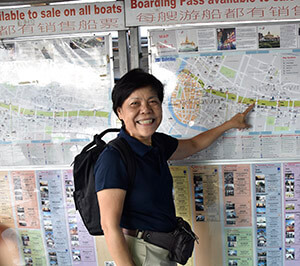
My friend Leky Ondej points out a destination on a map of the river.
Leky secured our very affordable hotel in Bangkok close to public transportation, a welcome change to stay put for consecutive nights after one-night stays in Bhutan. As we checked in, she introduced us to Anouk, who would be the trip leader for an Overseas Adventure Travel group just arriving from the U.S. It felt like old home week visiting with fellow travelers and knowing – from my earlier Southeast Asia trip – what the next three weeks would hold for them.
Leky had prepared a comprehensive but flexible itinerary. It included some of the sites I had seen the last time, but it was also filled with surprises, new people to meet and other spectacular places to see. With only three of us, we were able to journey to more places and spend more time there.
Transportation included the familiar tut-tuts, three-wheeled motorized vehicles that dart in and out of traffic with much the same grace as motorcycles. They’re much quicker than taxis, and while they may cost a little more, that’s offset by the open-air ride and the fun. We rode the very modern sky train from one end of the city to the next. We took taxis a couple of times and Leky arranged for a nice roomy van for our day to visit the floating market, the runaway market and a few other sites.
Venice of the East
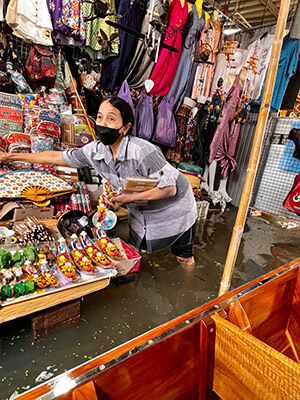
A souvenir-selling merchant stands knee-deep in water in the flooded Floating Market.
The Chao Phraya River runs through Bangkok into the Gulf of Thailand. Although the river was flooded – as were parts of the city and the outlying areas – we rode in both larger boats and smaller craft, depending on where our journey took us. We passed by barges, riverboats and private vessels. We also traveled along the city’s canals; in some circles Bangkok is called the Venice of the East.
Our first day we visited the Jim Thompson House, residence and headquarters for the famous American silk merchant whose life is surrounded in mystery. A veteran of World War II, from the 1950s until the late 1960s, he lived in Bangkok across a canal from the many silk weavers, realizing that his business acumen and design sense could revitalize the Thai silk industry.
The story goes that on March 26, 1967, he disappeared while visiting friends outside the city. An extensive search turned up no clues. But his legend and his amazing silk creations live on in the Jim Thompson House Museum and the Jim Thompson Art Center. His silk was used to make the costumes in the original “The King and I” musical film, starring Yul Brenner.
Of course, the Floating Market is a must-visit, although with recent rains the water ran about 3-5 feet higher than usual. That didn’t stop the vendors who lined the concrete piers in the canals from hawking their wares from clothing to spices, souvenirs to food. Some vendors sold from their hand-hewn boats, providing coconut ice cream, noodles and typical Thai fare.
A moving market
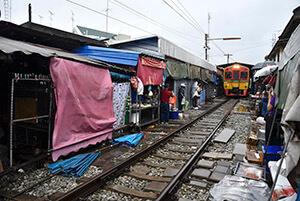
A train passes through the Runaway Market, forcing vendors to move their wares away from the tracks.
The Runaway Market, set up along the train tracks ink the nearby town of Samut Songkhram was quite a surprise. Vendors selling fresh meats, prepared meals, fruits, vegetables, clothing, shoes and souvenirs filled the spaces within inches of the track. As the train left the station, vendors scrambled to move their wares 3 to 4 feet away from the track, just to put it all back in place once the train passed. This happens several times a day.
We visited the tallest stupa in Thailand in Leky’s hometown of Nakhon Pathom. Stupas, tall towers that can be gold-covered, studded in porcelain and clay flowers, or plaster, can be found in many Buddhist countries. Built to hold religious relics and draw Buddhists to mediation, they can range from a couple of feet tall to the one she shared, which stands more than 395 feet tall on a base with a circumference of over 770 feet.
The Grand Palace can be overwhelming with its nearly 50 buildings in the 53-acre complex. Its central attraction, the Temple of the Emerald Buddha, is actually made of jade. Nearby, the temple of the Reclining Buddha features a golden Buddha in the Nirvana position. At 148 feet long, it is one of the most famous Buddha statues in the world.
One morning, we rose before dawn for traditional almsgiving at a nearby temple. Each day, the monks who live in the temples rely on alms for their daily meals. Members of the community and other visitors provide fresh fruit, cooked rice, prepared meals and other foods that will be eaten at one of their two daily meals – breakfast and lunch that must be eaten before noon. The rest of the time, the monks fast.
Later we visited another temple where the monks prayed and chanted each afternoon. Hearing the droning tones aids in meditation and focus for their singular lives of service and reverence.
A Chinatown?
Leky had more in store for us, including a visit to “Hidden Bangkok,” where many tourists never come. In the heart of the city, we were surprised to find an active Chinatown, bustling with vendors, restaurants, shops and street markets – all with signs written in Chinese. For lunch, we were the only tourists in the crowded restaurant where we had typical Chinese fare of Peking Duck. As we left, I noticed a pair of roasted ducks hanging in a heated case waiting to feed the next customers.
Our time in Bangkok passed much too quickly, but Christine and I left with precious memories of this amazing city and its culture. Best of all, when Leky dropped us off at the airport, it was with the promise to see her again. Maybe next time, she’ll come to see me in Northeast Georgia and I can introduce her to our lives near Lake Lanier and the mountains, and of course, the rest of the South.
Photos: by Pamela A, Keene

